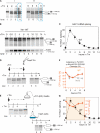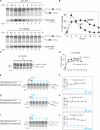Attenuation of yeast UPR is essential for survival and is mediated by IRE1 kinase
- PMID: 21444691
- PMCID: PMC3082189
- DOI: 10.1083/jcb.201008071
Attenuation of yeast UPR is essential for survival and is mediated by IRE1 kinase
Abstract
The unfolded protein response (UPR) activates Ire1, an endoplasmic reticulum (ER) resident transmembrane kinase and ribonuclease (RNase), in response to ER stress. We used an in vivo assay, in which disappearance of the UPR-induced spliced HAC1 messenger ribonucleic acid (mRNA) correlates with the recovery of the ER protein-folding capacity, to investigate the attenuation of the UPR in yeast. We find that, once activated, spliced HAC1 mRNA is sustained in cells expressing Ire1 carrying phosphomimetic mutations within the kinase activation loop, suggesting that dephosphorylation of Ire1 is an important step in RNase deactivation. Additionally, spliced HAC1 mRNA is also sustained after UPR induction in cells expressing Ire1 with mutations in the conserved DFG kinase motif (D828A) or a conserved residue (F842) within the activation loop. The importance of proper Ire1 RNase attenuation is demonstrated by the inability of cells expressing Ire1-D828A to grow under ER stress. We propose that the activity of the Ire1 kinase domain plays a role in attenuating its RNase activity when ER function is recovered.
Figures




Comment in
-
Putting the brakes on the unfolded protein response.J Cell Biol. 2011 Apr 4;193(1):17-9. doi: 10.1083/jcb.201101105. Epub 2011 Mar 28. J Cell Biol. 2011. PMID: 21444688 Free PMC article.
References
Publication types
MeSH terms
Substances
Grants and funding
LinkOut - more resources
Full Text Sources
Molecular Biology Databases

